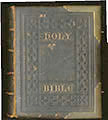FOSTER of Launceston, Australia, Chapter 4.
The "FOSTER Family" section of this site is divided into 13 chapters and 8 sets of appendices. Please read in sequence by following the links at the bottom of each page or use the "Quick Nav" at top right. If you wish to select individual chapters, please click on the top left link to the Sitemap page. Note the styles: links to individual images: …#02 . See the index to all these images here. Thumbnail images are shown below. Please click on these, for the full images within the Grandma photogallery. Citation of sources is shown as …ix) referring to the list at the end of this chapter.
Contents of this Website are subject to Copyright © by Philip Strong, & allow fair academic use. See here.
Do you have information, opinion or a question relating to either this site’s contents or its copyright? Please use the e-mail link available at the bottom of each page. I look forward to corresponding with you.
This page describes George FOSTER’s life in retirement from 1879 and also looks at what remains of his home and family in present day Launceston.
- Inside this chapter: |
- 1879 Events |
- Launceston Retirement: 1879 to 1899 |
- Present Day: Launceston |
1879 Events: Retirement, Family Gathering, Family Bible, New House!
Please click on these thumbnails for a full images with text.
Family photo in 1879 …#1; Family Bible also dated 1879 on flyleaf…#24.
George’s effective retirement in January 1879 is described in detail below, with links to newspaper articles. His family probably gathered together in 1879 to celebrate this milestone… click on the thumbnail photo above. The ages of his children in the photo suggest 1879. Perhaps his family presented him with the rather expensive family Bible at this gathering. The Bible was only found by chance! Click on the thumbnail Bible photo above. George's new 1879 house was reported in that year and is described with a number of photos…see below.
The latest discovery relating to George's 1879 "annus mirabilis" was made in July 2021 when I bought a heavy family King James Bible (5.2kg, 32 X 25 X 8cm) which had been earlier bought in Melbourne in 1980, perhaps derived from the estate of William Wood FOSTER who lived at Tennyson St, Sandringham Victoria when he died on 24 Mar 1909. The only link to our family was the writing on the fly-leaf shown below. How many George FOSTERs bought an expensive Bible like this in Launceston in 1879? The heavy brass corners of the covers had provision for two brass locks. The Bible was printed by Oxford University Press in 1875. It had the original 1611 edition prefaces: a one page ascription to King James and a seven page preface "Translators to the Reader". This latter statement sets out what the objectives of the translators were, why the translation is justified, answering objectives from both Catholics and Calvinists who object to a new translation, and explaining the translation philosophy of the authors. There were extensive sidenotes on both sides of every page and there were 13 woodcut engravings on heavy board… 7 in the Old Testament and 6 in the New. All edges of the pages were gilded. Unfortunately for the family historian there were no family records!
 George FOSTER Bible
George FOSTER BibleWhy Launceston on the fly-leaf? Previous chapters show that our George lived in Launceston at least from 1853. Why January 1879? George retired about Jan 1879 and thus he would have regarded this date as the start of the rest of his life.
Was this our George’s handwriting? I compared the (1) Bible entry…i) with known examples of George's writing: (2) 1839 Marriage Register;…ii) (3) 1845 Indenture of Release;…iii) (4) 1880 First codicil of George’s Will;…iv) (5) 1892 Third codicil of George’s Will.…iv); and on the Pilots report book.…v) All samples were of un-ornamented copperplate script. Looking closer, I found the the small scriptal flourish which George used on the end of the horizontal line in the capital F of Foster. This was common to samples 1,2,3 but not in his signature in the legal office in 4 and 5.
Conclusion? The Bible probably belonged to our George.
Launceston Retirement: 1879 to 1899
When George retired in Jan 1879 he had an unparalleled length of service in the Colony with 1(?) year as second mate from 1834, 1 year as assistant harbourmaster, 1 year as leadsman, 22 years as pilot, and finally 19 years as senior pilot in charge of the Low Head station. A total of 44 years service with 41 as pilot! Wayne Shipp's information on the length of service of the pilots in J.G. Branagan "The Historic Tamar Valley" shows George with 42 years as pilot, then the next longest services in order as 32, then 28, 27, 25, 24, 24, 16 and so on.…vi) He left the service very highly regarded by the people of Low Head and George Town. See transcriptions of these newspaper articles: “Meetings of the Launceston Marine Board, January to April 1879. Matters relating to George FOSTER’s retirement” here. “George FOSTER’s Testimonial at his Retirement” here.
 George FOSTER’s front door.
George FOSTER’s front door. Photo: D. Burbury, 2003 …ix)
George built his home at 41 William St, Launceston in 1879… it is now permanently placed on the Tasmanian Heritage Register (Id# 4700).…vii) A newspaper article on “Town improvements” said:
The general appearance of Launceston has been greatly improved within the past two years by the erection on all sides of buildings of every description, from the unassuming four-roomed weatherboard cottage to the handsome villa, and from the unpretentious little shops of the back streets, to the large establishments which adorn our principal thoroughfares. In this article I purpose noticing only new buildings which have gone up in the past few months… I then made my way into William-street, and there came across a handsome and compact 2-storied residence, erected for Mr Foster, ex-senior pilot.…viii)
The 1880 roll of William-street properties (see "Property") showed that George owned and occupied a house (£42) and owned a house and bakery (£45) occupied by M. Munro.…x)
George made a succession of codicils to his will which throw light on changing family circumstances as well as on people in the Launceston community who were important to the FOSTERs. George's good friend (and father-in-law) John Hammond died in 1870 causing George to make a first codicil to his will dated 28 Jul 1880. In the codicil George called himself "formerly Pilot of Tamar Heads, now gentleman of Launceston". The codicil replaced J. Hammond as executor with George Babington (Town Surveyor). George Babington was Launceston's Town Surveyor from 1853- 1882 and from 1863- 1882 was also Superintendent of Waterworks and Surveyor under the Building Act. G. Babington died on 29 Dec 1888 and George's son Thomas continued residing out of Tasmania, so George made a second codicil on 16 Jan 1889, appointing new executors Peter McCracken (Ironmonger) and Thomas Gladman (Accountant). Peter McCracken ran his own ironmonger's business at that time (from 1883 to 1894 in Charles St.), was elected to the Municipal Council twice after 1894 and was mayor in 1896. He was then elected to the House of Assembly in March 1900 and thus obtained probate for George FOSTER's estate just before his election campaign. Thomas Gladman at that time of the second codicil was accountant to the firm of Douglas & Collins, Solicitors who later acted to obtain George's probate. Thomas Gladman was elected City Treasurer and Accountant in the following year (1890).…iv), xi)
The value of George's estate increased. In 1892 the house where George lived was #41 (£40) and M. Munro's rented bakery was #43 (£45) (from 1892 at least, the modern-day street numbers applied). George died in 1899, and in 1900 #41 (£750) and #43 (£850) were still shown as owned by George. In 1910 these properties... #41 (£800) & #45 (£1,000) were no longer owned by the FOSTER family.…x) It is probable that George's properties were sold just before his death at less than their total assessed value of the time of £1,600. The probate value of George's estate was given as £1,296 and no real estate was included in his estate inventory.…iv) At that time George would have been quite well off, since as well as his assets he received an annual government pension in 1899 of £186/13/4. The 1907 ‘basic wage’ case gives an idea of the value of money in those days:
In the Harvester Decision, Justice Higgins of the Arbitration Court decided that 7 shillings a day, or 42 shillings a week, was fair and reasonable wages for an unskilled labourer. This became the basis of the national minimum wage system in Australia. It was a ‘living’ or ‘family’ wage, set at a level which would supposedly allow an unskilled labourer to support a wife and three children, to feed, house, and clothe them. By the 1920s it applied to over half of the Australian workforce. It became known as the ‘basic wage’. …xii)
George’s will left everything in trust to his wife Lucy and then, on her death, to his daughter Emily, should she be unmarried, the income from £500 plus the use of household furniture and effects in trust. The residue of the estate was to be divided equally amongst the children. The special provisions for Emily were introduced in a third codicil dated 3 Sep 1892, which suggested that she lived with George and Lucy and looked after them when they were old. This last codicil was witnessed by H.M. Latham (Civil Servant) and James Boag (Brewer).…iv) This Boag was J. Boag II who lived several doors down from George in 1884. Henry Francis Maude Latham was in the Customs Department at Launceston at the time, and the following year (1893) he was appointed Warehouse Keeper and also Collector of Beer Duty for Northern Tasmania. James Boag, born at Launceston in 1854, "...joined the staff of the (Esk) brewery"... in 1870.…xi) Note that the Esk Brewery was later named the James Boag Brewery and now owns George Foster's house and the adjacent Tamar Hotel… see below.
George died on 5 Nov 1899 at William St at the age of 96. The doctor in the imprecise manner of the time said he died of senility (old age).…xxi) Lucy died almost 2 years later on 2 Apr 1901 at 41 William St at the age of 81 of senility and heart disease.…xxii)
George and Lucy were remembered in an old lady's memoirs of her childhood in the 1890’s. She recalled that: "Next to the Tamar Hotel lived the FOSTERs, a very superior English family".…xiii) She also remembered their relationship with their son William Wood FOSTER and his brassworks. "Mr. Rankin and Mr. Bond worked at Foster's Brassworks and later took over the firm which now bears their names".…xiii)
Present Day: Launceston
The photo below shows significant recent change around George's home. In 2000 this area gave a derelict impression. The 2000 photo, on the left, shows the sheet metal gates and overgrown shrubs in George's drive, and the neighbouring Tamar Hotel in need of repair. The 2003 photo, on the right, shows the restoration in 2002 of the Tamar Hotel, the wrought iron style gates on George's drive and the tarred surface and parking area in George’s back yard. The parking area now serves the Tamar Hotel … named initially the "Boag's Centre for Beer Lovers" and now "The James Boag Brewery Experience" which is used for a bar, restaurant, display centre, guided tours and administration… see here.
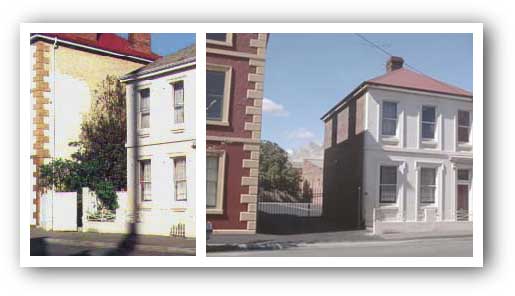 Changes in George FOSTER's House
Changes in George FOSTER's House Photos: PD Strong, 2000 & D. Burbury, 2003 …ix)
I visited George’s old house in November 2000. It was an impressive two-storey double brick building with a heritage listed facade. The main building was 7.5m × 10m. It was the only residential house in the immediate area and was owned by Boag’s Brewery which had rented it to their employees.
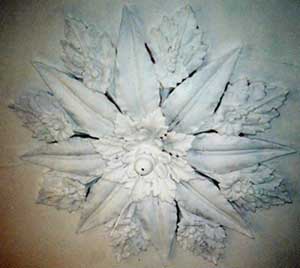 Plaster ceiling rose
Plaster ceiling rose in George FOSTER's home
The inside smelled very musty, due perhaps to the absence of a damp course combined with the modern paints on the thick interior plaster, which did not allow the surface to "breathe".
Upstairs were two large rooms… presumably a front bedroom and a rear master bedroom. There was also a small nursery room (or servant quarters?). Downstairs, there were another two large rooms with 14' ceilings. The front room was a lounge room with an ornate marble fireplace and a huge plaster ceiling rose (pictured on left). The back room was a large dining room. At the back of the house, a passage way led past a pantry and a bathroom to a large kitchen annexe. The toilet was outside. The block of land was quite large and the back yard could have been a good vegetable garden. The yard had a fair sized tree, was overgrown and had a tumbledown garage and shed, both built more recently. I wondered how George managed to heat the house and chop the wood for all his fireplaces. However in the probate documents there was a bill from the gas company amongst the liabilities.…iv)
In the 2002 renovations the garage and shed and old garden were removed to make way for the parking area, though the tree remained.…ix) The sign next to the tree in the below photo says:
Walnut Tree. Please do not touch the tree. This walnut tree is believed to date from the 1850s, and forms part of the cultural significance of the James Boag Brewery Experience and the surrounding area, which is a heritage listed site. To ensure the tree's longevity and your personal safety, please refrain from touching, climbing or shaking the tree. Thank you James Boag.…xiv)
How old is the tree? George FOSTER obtained the grant of his William-street land from Joseph Cordell in 1844.…xv)
This means the tree could be as much as 177 years old, if George planted the tree as soon as he got the grant! We could settle this question if we could ask an academic specialist in the area of aging trees (dendrochronologist) to make a fine-bore hole and extract the core with an increment borer and count the tree rings.
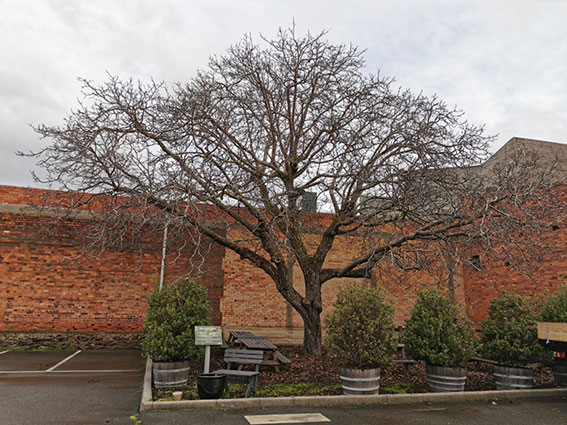 George FOSTER’s walnut tree.
George FOSTER’s walnut tree.Photo: Jai Paterson 2021. …xvi)
George's house has not been changed, though Boags stated: "In the future we may decide to renovate it and use it as part of the Boag's Centre for Beer Lovers complex. At this time we do not have any intention in the short term." In 2004 Boags painted George’s house to match their Centre’s colours.
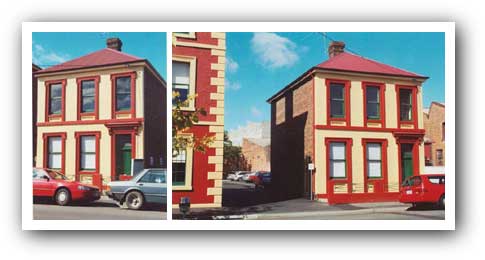 George FOSTER’s house further renovated.
George FOSTER’s house further renovated.Photo: Keith Ison, 2004. …xviii
John & Lorraine Stevens (descendants of George FOSTER’s daughter Annie STEVENS) visited the house in Nov 2008. Their photo (below) showed that the kitchen annexe had been replaced by a brick store-room with well designed access. They were told by Boag’s Centre for Beer Lovers that the old home is being used by Boags Brewery as an office and store room.…xviii)
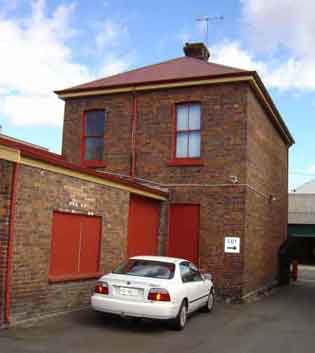 New store room at rear of house.
New store room at rear of house.Photo: John & Lorraine Stevens, 2008.…xviii)
I searched for George and Lucy’s graves. Sally Vandenberg said:
"Some of the headstones in Cypress St (Anglican) Cemetery were moved to the Carr Villa Cemetery prior to the site being turned into a sports field. Those headstones not moved by relatives were removed by Council, a few headstones were placed around the perimeter but most were removed and /or destroyed at the time. The sports field belongs to the Launceston Church Grammar School and is known as Broadland Park." …xix)
I wrote to Launceston Church Grammar School in 1999 and a search was subsequently made in that year: "a search of of the school grounds was made for headstones. Fragments were collected and formed into a memorial cairn at Broadland Park. Research on the fragments revealed the following list of names:
BRANSGROVE, Thomas FLETCHER, Agnes Mary FORD, Susannah GAUNT, William HOBKIRK, Frances Helen HOBKIRK, Frances Mary HOBKIRK, John Peter HOBKIRK, Horace Wakeman JOHNSON, Martha SIGGINS, Thomas WOODE".
…regrettably FOSTER was not amongst the fragments. In 2012 I wrote to the D.V. Gunn Archives - Launceston Church Grammar School, but the archivist had no records.…xx)
Sources:
(i)George FOSTER Bible kept by Philip Strong.
(ii) Marriage of George James FOSTER & Lucy HAMMOND, 2 Aug 1839. Marriages in the District of Launceston. Microfilm of Register kept in the Tasmanian Archives. See here.
(iii) Memorial of an Indenture of Release dated 23 August, 1845... the parties George Foster of George Town, George and Thomas Foster of Low Head, John Hammond of Launceston (general dealer) and John Scott (pilot) of Launceston. Deeds Library of the Titles Registry in Hobart. Lands Department Document #1175.
(iv) Probate of the Last Will and Testament and related documents for George FOSTER. Tas Archives: Probate file# AD 960/22 No 5534.
(v)Heads Pilots Report Book Jan and March 1875. Low Head Pilot Station Archives.
(vi) List of Pilots. Branagan, JG. The historic Tamar valley: its people, places and shipping— 1798-1900. Regal Publications Launceston; 1991;180-181.
(vii) 41 William St, Launceston. Tasmanian Heritage Register, Id# 4700.
(viii) Town improvements. Launceston Examiner 16 Aug 1879.
(ix) Douglas Burbury. Pers. comm. Photo 41 William St, Launceston, 2003.
(x) Launceston Rate Assessment Rolls: Schedule required by the Act to establish Municipal Councils in the City of Hobart Town and Town of Launceston , published in the Hobart Town Gazette, and later after 1900 in the Tasmanian Government Gazette. 4/4/1853 p 263, 20/3/1855 p 417, 17/2/1860 p 295, 21/11/1865 p 2017, 13/12/1870 p 1462, 21/12/1880 p 1362, 1884, 1892, 15/5/1900 p 711, 31/10/1910 p 1583. See here. s
(xi) Cyclopaedia of Tasmania", Vol II. Maitland and Krone, Hobart; 1900.
(xii) Fair Work Commission Website. The Harvester Case, 8 November 1907. See here.
(xiii) Veda Veale. Making of Memories: Memories of Launceston. Regal Press; Launceston; 1988: 22.
(xiv) Andrew Oliver, Venue Manager, James Boag Brewery Experience. Pers comm 2021.
(xv) George Foster transfer of grant from Joseph Cordell. Hobart Town Gazette. 1844; p. 1315.
(xvi) Jai Paterson. Photo of George FOSTER’s walnut tree. Pers. comm. 2021
(xvii) Keith Ison. Photo of 41 William St. Pers. comm. 2004
(xviii) John and Lorraine Stevens. Photo of new store room at rear of house. Pers. comm. 2008.
(xix) Sally Vandenberg, State Library Tasmania, Launceston Local Studies. Location of FOSTER headstone. Pers. comm. Jul 5, 1999.
(xx) Launceston Church Grammar School: Pers. comm. Principal 1999; D.V. Gunn Archives 2012.
(xxi) Death of George FOSTER, 5 Nov 1899. Deaths in the district of Launceston. Reg# 1899/71, Tas. Archives. See here.
(xxii) Death of Lucy FOSTER. Deaths in the district of Launceston. Reg# 1901/95, Tas. Archives.
Acknowledgements.
Many thanks to Des Wooton , curator of the Low Head Pilot Station Archives. Also to Douglas Burbury, Boag’s Brewery, Jill Gooden, Lorna and Murray Barclay, John and Lorraine Stevens, Keith Ison, Jai Paterson, State Library Tasmania… all of whom have given invaluable help over the years.
The Story Continues
- Chapter 5 This page gives an overview of George FOSTER’s children.

